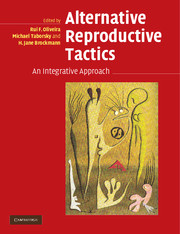Book contents
- Frontmatter
- Contents
- List of contributors
- Preface
- 1 The evolution of alternative reproductive tactics: concepts and questions
- PART I ULTIMATE CAUSES AND ORIGINS OF ALTERNATIVE REPRODUCTIVE TACTICS
- PART II PROXIMATE MECHANISMS OF ALTERNATIVE REPRODUCTIVE TACTICS
- PART III TAXONOMIC REVIEWS OF ALTERNATIVE REPRODUCTIVE TACTICS
- PART IV EMERGING PERSPECTIVES ON ALTERNATIVE REPRODUCTIVE TACTICS
- Index of species
- Subject index
- References
1 - The evolution of alternative reproductive tactics: concepts and questions
Published online by Cambridge University Press: 10 August 2009
- Frontmatter
- Contents
- List of contributors
- Preface
- 1 The evolution of alternative reproductive tactics: concepts and questions
- PART I ULTIMATE CAUSES AND ORIGINS OF ALTERNATIVE REPRODUCTIVE TACTICS
- PART II PROXIMATE MECHANISMS OF ALTERNATIVE REPRODUCTIVE TACTICS
- PART III TAXONOMIC REVIEWS OF ALTERNATIVE REPRODUCTIVE TACTICS
- PART IV EMERGING PERSPECTIVES ON ALTERNATIVE REPRODUCTIVE TACTICS
- Index of species
- Subject index
- References
Summary
CHAPTER SUMMARY
Here we outline the meaning of the term alternative reproductive tactics, or ARTs, and discuss why the existence of ARTs is so widespread in animals. We ask what we need to know to understand the evolution of ARTs and the importance of general principles such as frequency dependence, density dependence, and condition dependence, and what we need to know about proximate mechanisms involved in the regulation of ARTs to comprehend evolutionary patterns. We discuss current issues in the study of ARTs and list 12 questions that we think need particular attention. Throughout we shall provide representative examples of ARTs in animals to illustrate the ubiquitous nature of this phenomenon.
WHAT IS THE MEANING OF ALTERNATIVE REPRODUCTIVE TACTIC?
Alternative
The concept of ARTs refers to alternative ways to obtain fertilizations in both males and females. In its most common use, this term refers to traits selected to maximize fitness in two or more alternative ways in the context of intraspecific and intrasexual reproductive competition. In general, alternative phenotypes are characterized by a discontinuous distribution of traits evolved towards the same functional end. Examples include size dimorphism, color polymorphism, dimorphic morphological structures involved in the monopolization of resources or mates, and various behavioral alternatives such as territoriality vs. floating, monopolization vs. scramble competition, or investment in primary access to a resource vs. social parasitism. Individuals allocate resources to either one or the other (mutually exclusive) way of achieving the same functional end using evolved decision-making rules (Brockmann 2001).
- Type
- Chapter
- Information
- Alternative Reproductive TacticsAn Integrative Approach, pp. 1 - 22Publisher: Cambridge University PressPrint publication year: 2008
References
- 115
- Cited by



